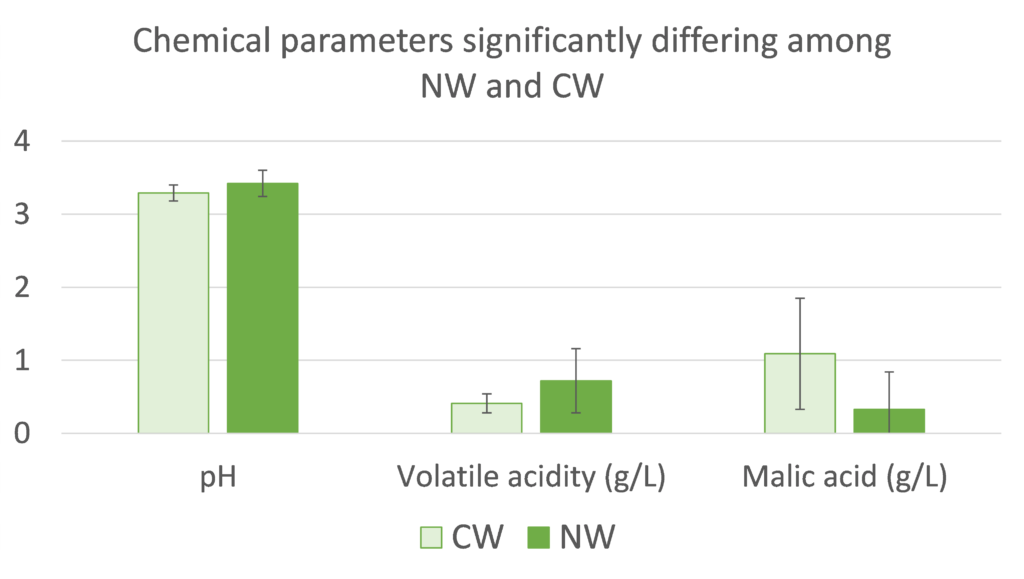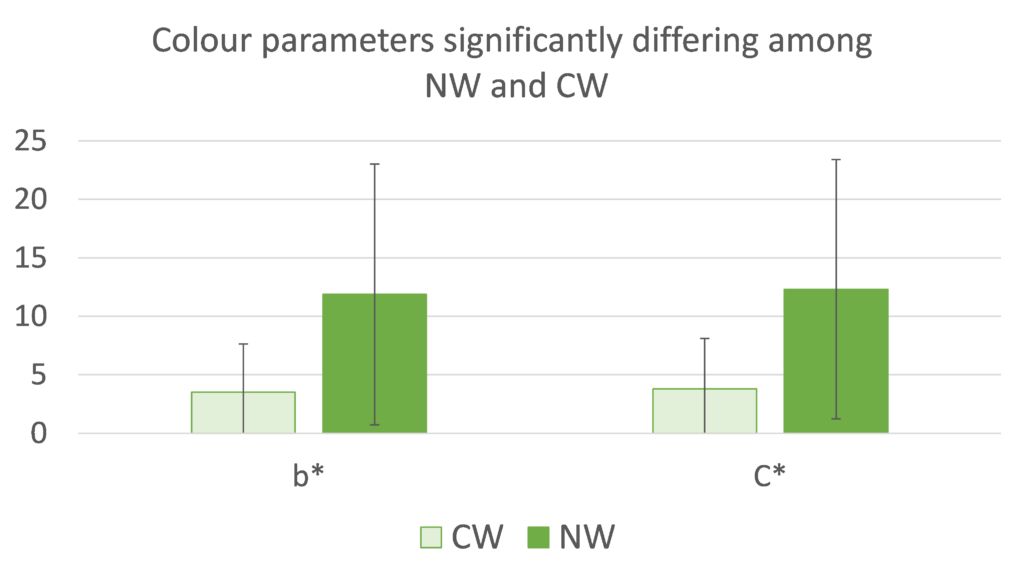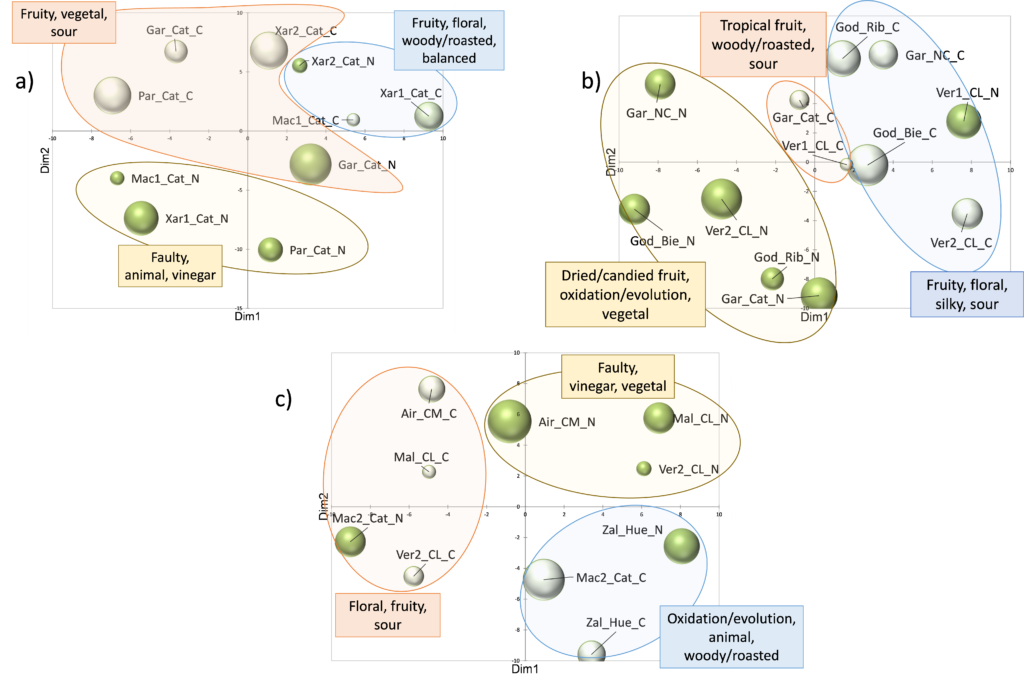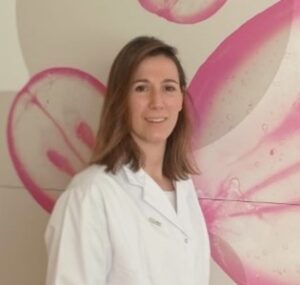by María-Pilar Sáenz-Navajas, Carlota Sánchez, Marivel Gonzalez-Hernandes, Mónica Bueno, Cristina Peña, Purificación Fernández-Zurbano, Jordi Ballester, Eva Parga-Dans, Pablo Alonso González
It is unquestionable that wine production and its market are experiencing a global change. The main drivers of this change are related to greater consumer awareness of healthier products and overall sustainability. To this regard, the market of organic wines held an estimated value of 9.83 billion USD in 2022 and it is expected to experience an annual growth rate of more than 10% until 2030 (Varma, 2022). The European Union has specific rules for wines to be organic. These rules are in line with the following overall organic production objectives and principles: promote environmental protection, maintain the biodiversity of Europe and build consumer trust in organic products. The specific rules that govern the production of organic wines are related to the grapes that have to be organically produced, as well as the yeasts employed during the fermentation process. The use of sorbic acid and desulphurisation is not allowed and the levels of sulphites must be lower than their conventional counterparts, which depends on the levels of residual sugar. Beyond organic wine, a new category has currently peaked consumer interest: natural wine. Different from organic wine, this category lacks an official definition, which is prompting a heated discussion around these self-defined natural wines (NW). The NW producers define the product as a wine produced with organic or biodynamic grapes with minimal intervention in the cellar (e.g. no deacidification, dealcoholisation or filtration), with minimal or no use of oenological additives. However, only a French union has recently (year 2020) officially regulated this category of production under the name of Vin Méthode Nature, even though NW associations with their own internal regulations have existed for decades in Europe (Pablo Alonso González & Parga-Dans, 2020).
Despite the interest aroused by natural wines, there is, to date, a lack of scientific knowledge that enables consumers to delineate a critical opinion about this relatively new category. Among all the aspects to be studied, our research focused on exploring the chemical and sensory properties of NW in comparison to their counterparts elaborated under conventional production (CW).
In this context, a set of 28 Spanish white wines was chopped from the Spanish retail market. Half of them were self-defined NWs and the other half were CWs. Wines were chopped in pairs with grape variety, vintage and region of origin in common in order to produce a balanced sample set.
Their chemical profiles were defined by analysing the following parameters: conventional oenological parameters, turbidity, biogenic amines, ochratoxin A, ethyl carbamate, sulphites, chlorides, some metals (lead, copper, zinc, arsenic, iron), and volatile compounds with sensory activity including major, trace, and Strecker aldehydes. Their sensory profile was also characterised by a group of 16 winemakers from the DOCa Rioja region by means of labelled free sorting task.
Figures 1 and 2 show the colour and chemical parameters significantly differing among both groups of wines (P< 0.05). Thus, pH and volatile acidity were higher in the NWs than in the CWs, while the contrary was observed for the malic acid content (Figure 1). Interestingly, NWs showed higher (x10) turbidity values (33±5 versus 3±2 NTU), and more intense yellow colour (related to b10* coordinate and C*, Figure 2). The NWs presented lower levels of total sulphur dioxide but significantly higher levels of the biogenic amine putrescine, although both toxics were within the legal limits in all cases. The rest of parameters did not present significant differences between the two categories of wines.

Figure 1. Chemical parameters showing significant differences among CW and NW. Error bars represent the standard deviation among wine of the same category.

Figure 2. CIELab colour coordinates showing significant differences among CW and NW. Error bars represent the standard deviation among wine of the same category.
Regarding their flavour profile, three independent sorting tasks were carried out in order to confirm the generalisation of results. For that, sorting task 1 comprised 10 wines (5 conventional and 5 natural) from the same region (Cataluña); sorting task 2, included 12 wines (6 conventional and 6 natural) sharing variety (Garnacha, Verdejo, Godello); and sorting task 3, contained 10 wines (5 conventional and 5 natural) with mixed varieties and regions. In each task, participants were instructed to taste samples in black standardised glasses and form groups based on their sensory similarity. Finally, they had to describe the groups with a maximum of three attributes.
Figure 3 shows the projection of the wines obtained from the three sorting tasks (Figure a-c). The groups of wines which were derived from the hierarchical cluster analysis (HCA) calculated on all dimensions of the multidimensional scaling (MDS) are marked in different colours.

Figure 3. Projection of the samples on the first three dimensions derived from the multidimensional scaling (MDS (extracted from three-dimensional solutions) calculated on the groups of wines formed by the panel of wine experts in the three sorting tasks performed. *The codes of wines correspond to the variety (Garnacha, Xarello, Parellada, Macabeo, Godello, Verdejo, Airen, Malvasia, Zalema), followed by the region (Cataluña-Cat, North-Center Spain-NC, Castilla y León-CL, Bierzo-Bie, Ribeiro-Rib, Castilla-La Mancha-CM, Huelva-Hue) and their production type (Conventional-C or Natural-N)
Groups of wines in yellow were formed by exclusively natural wines in the three sortings. They were characterised by terms such as faulty, animal, vinegar, dried/candied fruit, oxidation/evolution and vegetal. Groups of samples in orange included mostly conventional wines, except for Gar_Cat_N in sorting 1-Figure 3a and Mac2_Cat_N in sorting 3-Figure3c. These groups present sensory profiles related to positive aromas such as fruity, tropical fruit, floral, vegetal and woody/roasted and sour taste. Finally, groups in blue were formed by both conventional and natural wines and were characterised with terms present in the other two groups including positive attributes such as fruity, floral, woody/roasted, sour, balanced, and silky, and negative attributes like oxidation/evolution and animal.
Overall, the results show that there is not a salient sensory dimension differing among NWs and CWs. However, 70% of the NWs were described with aromatic defaults mainly related to their higher content in 4-ethylphenols and volatile acidity, while 30% were not differentiated from their conventional counterparts. In relation to wine appearance, NW showed significantly higher levels of turbidity and a more intense yellow colour which can be explained respectively by the lack of filtration and the lower doses of SO2. Interesting to remark is that among the 30% of NWs (4 wines) that show default-free sensory profiles, two of them show levels of SO2 as high as 82 and 120 mg L-1.
This exploratory study provides the first glimpse into the still enigmatic world of natural wine production. While there are many steps to go to avoid default-related profiles (70% of NWs studied), the results are encouraging in that natural production can lead to quality wines when the process is optimised. This is the case of two out of the 14 NWs evaluated, because the other two samples self-defined as natural showed levels of SO2 higher than 80 mg L-1. To this regard, this study also raises doubts as to whether the wines are as natural as they say they are, and calls for the need for a regulation of this wine category (Alonso González, Parga Dans, & Fuentes Fernández, 2022) in order to guarantee a coherence between the information present on the label (natural) and the production.
Read the paper here:
by María-Pilar Sáenz-Navajas1*, Carlota Sánchez1, Marivel Gonzalez-Hernandez1, Mónica Bueno2, Cristina Peña2, Purificación Fernández-Zurbano1, Jordi Ballester3, Eva Parga-Dans4, Pablo Alonso González4
1Instituto de Ciencias de la Vid y del Vino (UR-CSIC-GR). Department of Enology, Logroño, La Rioja, Spain
2Laboratorio de Análisis del Aroma y Enología (LAAE). Departament Analytical Chemistry, Faculty of Sciences. Universidad de Zaragoza. Instituto Agroalimentario de Aragón-IA2 (Universidad de Zaragoza-CITA). Zaragoza, Spain.
3Centre des Sciences du Goût et de l’Alimentation, CNRS, INRAE, Université Bourgogne Franche-Comté, Dijon, France
4Instituto de Productos Naturales y Agrobiología, IPNA-CSIC, La Laguna, Santa Cruz de Tenerife, Spain

María-Pilar Sáenz-Navajas holds bachelor degrees in Chemistry and Enology from La Rioja University. She went on to complete a PhD (year 2011) on wine sensory interactions and non-volatile sensory-active molecules driving wine quality at the same University. The PhD involved innovative work on sensory interactions in wines by construction/deconstruction strategies combining sensory and chemical sciences.
She was a postdoctoral fellow at the Center for Flavor and Feed Sciences in Dijon, France, from 2011 to 2013, where she acquired expertise in Sensory and Consumer Science. She visited the University of California Davis (Prof. Dr. Waterhouse Lab) in 2016, and the University of Adelaide in 2022 (A/Prof D. Jeffery).
From 2013 to 2020, Dr Sáenz-Navajas worked at Universidad de Zaragoza at Laboratorio de Análisis del Aroma y Enología, at Prof. Ferreira´s lab, where her research was focused on the development of conceptual, instrumental and methodological tools for the modelling of flavour.
Since 2021 she is tenured research scientist at The Spanish National Research Council (CSIC) and develops her research at the Institute of Grapevine and Wine Sciences, in La Rioja, Spain, where in collaboration with her former lab at University of Zaragoza, continues her research line following a multidisciplinary approach focused on modelling wine flavour from sensory-active molecules, and trying to understand how these molecules interact with the consumer to form the overall perception, by employing strategies derived from cognitive psychology, chemistry and enology.
References
Alonso González, P., & Parga-Dans, E. (2020). Natural wine: do consumers know what it is, and how natural it really is? Journal of Cleaner Production, 251, 119635. doi: https://doi.org/10.1016/j.jclepro.2019.119635
Alonso González, P., Parga Dans, E., & Fuentes Fernández, R. (2022). Certification of Natural Wine: Policy Controversies and Future Prospects. Frontiers in Sustainable Food Systems, 6. doi: 10.3389/fsufs.2022.875427
Varma, J. (2022). Organic Wine Market Analysis and Segment Forecast to 2030, from https://www.grandviewresearch.com/industry-analysis/organic-wine-market-report

